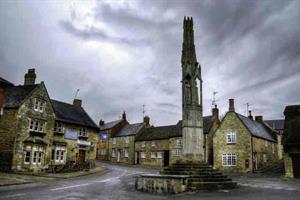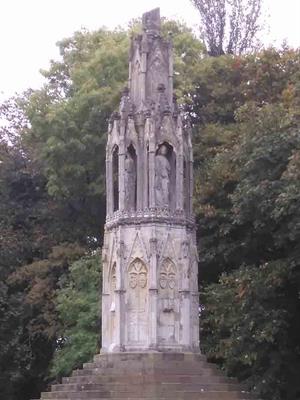Eleanor of Castile (1241-1290) was a medieval Queen. When Eleanor died, her husband, King Edward I, ordered a large funeral procession between Lincoln Cathedral and Westminster Abbey. A memorial cross was built at each overnight stop. Three crosses remain today and two are in Northamptonshire.
Eleanor of Castile was born in Spain in 1241. Her parents were Spanish royalty and she was married young to the heir to the English throne in a political marriage. When Eleanor married Prince Edward in 1255, they were both children. However, it was a love match and they were very happy together. They had sixteen children in their long marriage.
Eleanor and Edward were inseparable and she went with him on crusades. When he was wounded in battle with a poisoned knife, Eleanor is said to have sucked the poison from his arm (as shown in the image at the top).
 In 1274, the couple were crowned King and Queen of England. Eleanor had little political influence. However, she expanded her estates through purchasing debts and seizing land for them. This was rare for a Queen and along with her harsh treatment of debtors, caused a scandal.
In 1274, the couple were crowned King and Queen of England. Eleanor had little political influence. However, she expanded her estates through purchasing debts and seizing land for them. This was rare for a Queen and along with her harsh treatment of debtors, caused a scandal.
Eleanor was also a patron of the arts and supported English universities.
When she died in November 1290, Edward was devastated. He ordered a large funeral procession to carry Eleanor’s body from Lincoln Cathedral to Westminster Abbey to be buried. A memorial cross was built at each of the twelve overnight stops en route. Three crosses remain today and two are in Northamptonshire.
 The Geddington cross is the best-preserved. It is a modest example of Gothic Decorated architecture.
The Geddington cross is the best-preserved. It is a modest example of Gothic Decorated architecture.
It is triangular in shape and features a carved coat of arms and three figures of Eleanor.
Originally, it was topped with a cross.
 The Hardingstone Cross was built by a stone mason called John of Battle and an artist called William of Ireland.
The Hardingstone Cross was built by a stone mason called John of Battle and an artist called William of Ireland.
It is octagonal in shape with three tiers and originally topped with a cross.
The bottom tier features carved open books, which were painted with inscriptions.